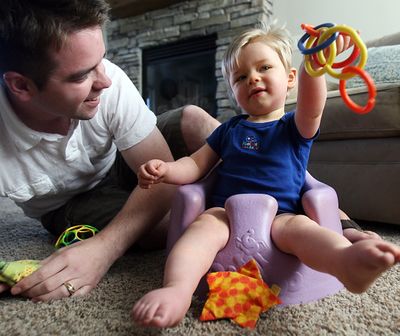Radical surgery quells seizures
Doctors remove left half of 19-month-old’s brain

BOISE – Evan Stauff smiles and giggles. He mimics his father in making silly noises. He loves to play with toys and watch cartoons.
The 19-month-old didn’t do any of those things before undergoing surgery this past winter to remove half of his brain, a procedure that’s called a “hemispherectomy.” His family noticed a change in his behavior almost immediately – starting with his ability to focus on family members, rather than look through them.
“It’s already a miracle,” said Evan’s grandmother, Karen Sands, of Payette, Idaho. “He’s a person now; he wasn’t before.”
Evan was diagnosed with infantile spasms when he was almost 3 months old. The spasms were the result of a specific kind of epilepsy that develops in young children.
They came in clusters, and his episodes lasted five to 15 minutes. Evan’s dad, 31-year-old David Stauff, believes he witnessed his baby go through thousands of spasms over a seven-month period before the surgery.
“His brain was always in a state of seizure,” said Kathleen Stauff, Evan’s mom. The baby was physically exhausted by the seizures and had a very erratic sleep pattern.
He was lethargic and catatonic – “trapped inside,” Sands said.
Before the surgery, Evan wasn’t able to sit up – or even able to hold his head up – and he couldn’t grab and hold toys. Now he’s able to sit and play on the floor of his grandparents’ Eagle, Idaho, home.
He’s still behind developmentally but is progressing.
“He’s doing really well. We couldn’t be any happier,” said his father, who quit his job at a credit union to care for the youngest of his three boys.
The Stauffs, who grew up in Payette and met in a high school geometry class, now live on the Oregon coast. They were back in the Treasure Valley recently, visiting their families, who traveled to Los Angeles in November when Evan had brain surgery at UCLA Medical Center.
The Stauffs have reached out to other parents in hopes of helping those whose children suffer from infantile spasms. They shared their story in an ABC News “Nightline” segment that aired in December and this summer attended the Hemispherectomy Foundation’s international conference at the Disneyland Resort in California.
“It’s all about turning this into a positive experience for others,” David Stauff said. “It was a very rough experience. It just blew me off my feet at first to just figure out what was going on, the frustration and uncertainty.”
After more than a half-dozen medications failed to calm the electrical storm in their son’s brain, the Stauffs hoped brain surgery would be the answer. Removing up to half the brain sounds drastic, and it is. But it’s different for young children because their brains are still growing.
“Anything they did was going to give me a better result than where I was at,” said Kathleen Stauff, recalling seven months of “crisis mode.”
The risks of not doing the surgery on Evan were significant. Cognitive development problems are associated with the frequent spasms, and children who suffer the condition often have IQs below 50, Mathern said. Some of those kids don’t recognize their own parents.
Evan’s brothers – Patrick, 8, and Chandler, 12 – say their baby brother is now very playful with them. He gets excited when they get off the school bus, and he is engaging.
“He’ll grab one of his blocks and throw it,” Patrick said.
Dr. Gary W. Mathern, the surgeon who operated on Evan, said Evan’s surgery would affect movement in his right hand, arm and leg, the right side of his vision in both eyes, language development and word/language-based memory. He is expected to be able to walk, though with a limp.
At his grandparents’ house this month, Evan was quite verbal. His baby talk included the word “Da-da,” bringing a smile to his dad’s face.
Evan spends time each week with a physical therapist, an occupational therapist and a speech pathologist.
Mathern recently saw Evan for his six-month follow-up visit.
“What you want to see is evidence of development since you did the surgery – new milestones,” Mathern said last week. “He’s clearly showing nice development progress.”
Mathern said 10 to 15 percent of those who undergo the procedure experience seizures later on, but they usually occur much less frequently. Evan has been seizure-free since his surgery.